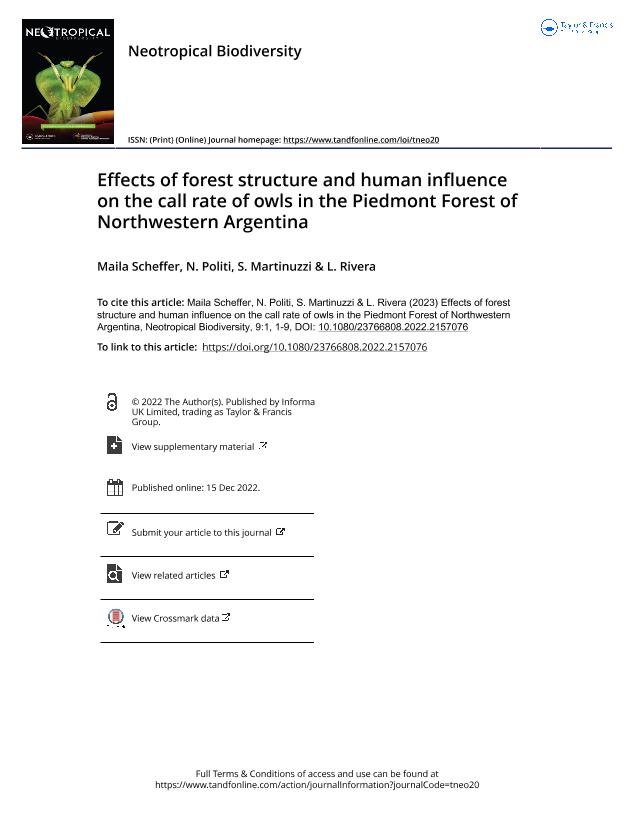Mostrar el registro sencillo del ítem
dc.contributor.author
Scheffer, Maila

dc.contributor.author
Politi, Natalia

dc.contributor.author
Martinuzzi, Sebastián

dc.contributor.author
Rivera, Luis Osvaldo

dc.date.available
2023-09-08T16:14:48Z
dc.date.issued
2022-12
dc.identifier.citation
Scheffer, Maila; Politi, Natalia; Martinuzzi, Sebastián; Rivera, Luis Osvaldo; Effects of forest structure and human influence on the call rate of owls in the Piedmont Forest of Northwestern Argentina; Taylor & Francis Ltd; Neotropical Biodiversity; 9; 1; 12-2022; 1-9
dc.identifier.uri
http://hdl.handle.net/11336/210964
dc.description.abstract
Owls (Strigiformes) play an important ecological role as predators that structure and organize biological communities. Specialized owl species dependent on old-growth forests have suffered declines because of forest loss or degradation by human activities. Few studies have been conducted on Neotropical owls, especially in the Piedmont Forest of Northwestern Argentina. The scarcity of information on habitat requirements and the effect of human impacts preclude the establishment of conservation and management activities. The human footprint index (HFI) is a tool for mapping human impacts on biodiversity that is used at global and regional scales, based on the estimated and standardized contribution of different human impact variables (e.g. road networks, urban centers, agricultural land, etc.). The objectives of this work were to: 1) Determine the call rate of five owl species in the Piedmont Forest of Northwestern Argentina, 2) relate forest structure to the call rate of owl species, and 3) relate human footprint index to the call rate of owls. We placed 28 automatic recorders in the Piedmont Forest, in sites with low and high Human influence, and characterized the forest structure around each recorder within a circular plot of 25 m diameter. We obtained 241 vocalizations in 168 intervals of 2 h for Ferruginous pygmy owl (Glaucidium brasilianum), Tropical screech-owl (Megascops choliba), Black-banded owl (Ciccaba huhula), Spectacled owl (Pulsatrix perspicillata), and Buff-fronted owl (Aegolius harrisii). We found that for Tropical screech-owl live tree basal area had a positive and diameter at breast height standard deviation had a negative influence on call rate. While for Black-banded owl, the dead tree density had a positive and human footprint index >1 had a negative influence on call rate. For Spectacled owl, dead tree density and human footprint index >1 had a negative influence on call rate. We provide first insights into the effects of forest structure and human influence on the call rate of owls in the Piedmont Forest of Northwestern Argentina, information that may guide forest management guidelines and conservation strategies.
dc.format
application/pdf
dc.language.iso
eng
dc.publisher
Taylor & Francis Ltd

dc.rights
info:eu-repo/semantics/openAccess
dc.rights.uri
https://creativecommons.org/licenses/by/2.5/ar/
dc.subject
OWLS
dc.subject
ACOUSTIC MONITORING
dc.subject
VOCALIZATIONS
dc.subject
HUMAN FOOTPRINT
dc.subject
FOREST STRUCTURE
dc.subject.classification
Conservación de la Biodiversidad

dc.subject.classification
Ciencias Biológicas

dc.subject.classification
CIENCIAS NATURALES Y EXACTAS

dc.title
Effects of forest structure and human influence on the call rate of owls in the Piedmont Forest of Northwestern Argentina
dc.type
info:eu-repo/semantics/article
dc.type
info:ar-repo/semantics/artículo
dc.type
info:eu-repo/semantics/publishedVersion
dc.date.updated
2023-07-07T19:51:46Z
dc.identifier.eissn
2376-6808
dc.journal.volume
9
dc.journal.number
1
dc.journal.pagination
1-9
dc.journal.pais
Reino Unido

dc.journal.ciudad
London
dc.description.fil
Fil: Scheffer, Maila. Universidad Nacional de Jujuy. Instituto de Ecorregiones Andinas. Consejo Nacional de Investigaciones Científicas y Técnicas. Centro Científico Tecnológico Conicet - Salta. Instituto de Ecorregiones Andinas; Argentina
dc.description.fil
Fil: Politi, Natalia. Universidad Nacional de Jujuy. Instituto de Ecorregiones Andinas. Consejo Nacional de Investigaciones Científicas y Técnicas. Centro Científico Tecnológico Conicet - Salta. Instituto de Ecorregiones Andinas; Argentina
dc.description.fil
Fil: Martinuzzi, Sebastián. University of Wisconsin; Estados Unidos
dc.description.fil
Fil: Rivera, Luis Osvaldo. Universidad Nacional de Jujuy. Instituto de Ecorregiones Andinas. Consejo Nacional de Investigaciones Científicas y Técnicas. Centro Científico Tecnológico Conicet - Salta. Instituto de Ecorregiones Andinas; Argentina
dc.journal.title
Neotropical Biodiversity
dc.relation.alternativeid
info:eu-repo/semantics/altIdentifier/url/https://www.tandfonline.com/doi/full/10.1080/23766808.2022.2157076
dc.relation.alternativeid
info:eu-repo/semantics/altIdentifier/doi/http://dx.doi.org/10.1080/23766808.2022.2157076
Archivos asociados
